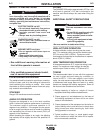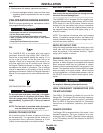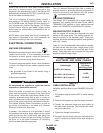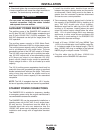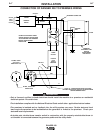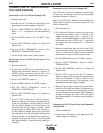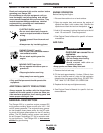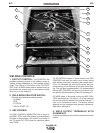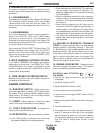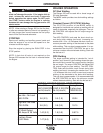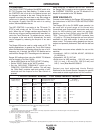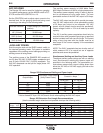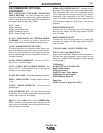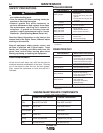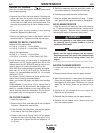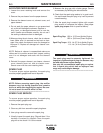
B-3
OPERATION
B-3
5. GROUND STUD: (graphic)
Provides a connection point for connecting the
machine case to earth ground for the safest grounding
procedure.
6. 14-PIN AMPHENOL:
For attaching wire feeder control cables to the Ranger
250. Includes contactor closure circuit, auto-sensing
remote control circuit, and 120V and 42V power. The
remote control circuit operates the same as the 6 Pin
Amphenol.
7. 6-PIN AMPHENOL:
For attaching optional remote control equipment.
When in the CC-STICK, PIPE, and CV-WIRE modes
and when a remote control is connected to the
Amphenol, the auto-sensing circuit in the Ranger 250
automatically switches the OUTPUT control from con-
trol at the welder to remote control .
When using the TOUCH START TIG mode with a TIG
Module connected to the Ranger 250, the OUTPUT
control on the front of the Ranger 250 is used to set
the maximum current range of the CURRENT CON-
TROL on the TIG Module.
8. WELD TERMINALS CONTROL SWITCH:
In the WELD TERMINALS ON position, the output is
electrically hot all the time. In the REMOTELY CON-
TROLLED position, the output is controlled by a wire
feeder or amptrol device, and is electrically off until a
remote switch is depressed.
9. WIRE FEEDER VOLTMETER SWITCH:
Matches the polarity of the wire feeder voltmeter to
the polarity of the electrode.
ENGINE CONTROLS:
10. RUN/STOP SWITCH - RUN position ener-
gizes the engine prior to starting. STOP position stops
the engine. The oil pressure interlock switch prevents
battery drain if the switch is left in the RUN position
and the engine is not operating.
11. CHOKE - When pulled out, it closes the choke
valve on the engine carburetor for quick starting.
12. START PUSH BUTTON - Energizes the
starter motor to crank the engine.
13. IDLER SWITCH- Has two positions as follows:
1) In the HIGH position, the engine runs at the high
idle speed controlled by the engine governor.
2) In the AUTO position, the idler operates as follows:
• When switched from HIGH to AUTO or after start-
ing the engine, the engine will operate at full
speed for approximately 12 seconds and then go
to low idle speed.
• When the electrode touches the work or power is
drawn for lights or tools (approximately 100 Watts
minimum), the engine accelerates and operates
at full speed.
• When welding ceases or the AC power load is
turned off, a fixed time delay of approximately 12
seconds starts. If the welding or AC power load is
not restarted before the end of the time delay, the
idler reduces the engine speed to low idle speed.
• The engine will automatically return to high idle
speed when there is welding load or AC power
load reapplied.
14. ENGINE ALTERNATOR TROUBLE
LIGHT-The engine alternator light is off when battery
charging system is functioning normally. If light turns
on, the alternator or the voltage regulator may not be
operating correctly. The light may also come on due
to the battery not holding a charge. It is normal for the
light to come on during shut down of the engine. The
light will remain lit with the meters for a short period of
time after the engine has shut down.
15. ENGINE HOUR METER – Displays the total
time that the engine has been running. This meter is
useful for scheduling prescribed maintenance.
STARTING AND STOPPING
THE ENGINE
1. Remove all plugs connected to the AC power
receptacles.
2. Set IDLER switch to AUTO.
3. Set the RUN/STOP switch to RUN.
4. Pull the choke to the full out position.
5. Press and hold the engine START button until the
engine starts.
6. Release the engine START button when the engine
starts.
7. Push the choke back in.
8. The engine will run at high idle speed for approxi-
mately 12 seconds and then go to low idle speed.
Allow the engine to warm up at low idle for several
minutes before applying a load and/or switching to
high idle. Allow a longer warm up time in cold
weather.
RANGER 250



